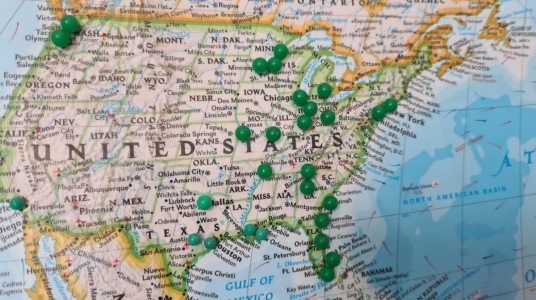From best to worst: How each state stacks up for senior care
- Replies 0
The quality of senior care across America depends heavily on where someone lives—and new research shows just how wide the divide can be.
RetirementLiving.com, a site dedicated to retirement resources and planning tools, has released a comprehensive ranking of all 50 states based on how they treat their elderly populations.
The analysis offers a revealing look into which regions provide seniors with the best chance to age comfortably and with dignity, and which ones are leaving older adults at risk.
For families making decisions about retirement or long-term care, the findings underscore the critical role geography plays in shaping health and well-being.
The study drew on the latest government statistics and nonprofit data to measure three key categories: health care accessibility, social factors, and the physical environment.
Analysts evaluated nursing home quality, preventable hospitalizations, and the availability of health care providers. They also examined rates of poverty and social isolation, both of which can erode seniors’ quality of life.
Environmental considerations, such as air and water quality and access to parks, rounded out the metrics. Taken together, the rankings paint a comprehensive picture of where seniors can expect to thrive and where systemic shortcomings may put them at risk.
Hawaii emerged as the clear leader, earning the title of the nation’s “gold standard” for eldercare.
The Aloha State performed strongly across all categories, with high-quality nursing homes, low hospitalization rates, and supportive community structures that help reduce loneliness among seniors.
Favorable weather and environmental conditions only strengthen its standing. Close behind was Minnesota, a state recognized for its robust health care access and relatively low levels of food insecurity.
Utah claimed the third spot, offering affordability, low social isolation, and an environment that researchers described as “conducive to healthy senior living.”
The rest of the top 10 include states that have invested in strong senior care systems and social supports:
For older adults living there, the result is more stability, less isolation, and greater opportunities for healthy aging.
Also read: Some places might surprise you as the best for seniors living alone
At the other end of the spectrum, Louisiana was ranked as the worst state in the nation for senior care. The study cited low-quality nursing facilities, high rates of preventable hospitalizations, and poor environmental conditions.
Air quality is below average, park access is limited, and the state’s drinking water quality ranked second-worst in the country. Together, these factors create serious risks for seniors, whose health is especially vulnerable to environmental stressors.
Mississippi followed close behind, weighed down by the nation’s highest rates of senior poverty and social isolation. West Virginia ranked third worst, driven by poor access to health care and the highest rate of preventable hospitalizations nationwide.
The rest of the bottom 10 include:
Also read: Retire in Bliss! Discover 24 U.S. Havens Where Happiness Soars, Taxes Plummet, and Your Dollar Stretches Further!
Jailyn Rodriguez, who led the analysis for Retirement Living, told Newsweek that the results reflect broader regional divides.
“The Retirement Living Research Team found that states in the Northeast and Upper Midwest generally come out ahead because they put more resources into senior services, have higher-quality nursing homes, and a stronger base of geriatric specialists,” Rodriguez explained.
“On the flip side, many Southern states face steeper challenges—things like higher rates of senior poverty and food insecurity, plus fewer healthcare providers. Those factors combined often translate into worse outcomes, including more preventable hospitalizations.”
Despite the challenges, Rodriguez noted that there are signs of progress. Access to geriatric clinicians has improved, rising to nearly 40 per 100,000 seniors in 2025, and hospice use has ticked up slightly.
Spending on community support programs has also held steady, suggesting ongoing investment in efforts to keep older adults connected and engaged.
Also read: Feeling blue? Globally speaking, America isn’t smiling much this year
However, other trends remain worrisome: preventable hospitalizations have increased slightly, while senior poverty and nursing home quality have both worsened.
These contradictions show that while progress is being made, the fight to improve senior care is far from over. The report leaves policymakers, caregivers, and families with stark choices.
As America’s senior population continues to grow, states at the bottom of the list face mounting pressure to close the gaps.
Whether through stronger health infrastructure, better environmental protections, or more robust social supports, experts say action is needed now to prevent worsening outcomes in the years ahead.
Read next: Where are seniors happiest in retirement? New study reveals the top states

Would you consider moving to another state for better senior care options? Join the conversation and share your thoughts in the comments below.
RetirementLiving.com, a site dedicated to retirement resources and planning tools, has released a comprehensive ranking of all 50 states based on how they treat their elderly populations.
The analysis offers a revealing look into which regions provide seniors with the best chance to age comfortably and with dignity, and which ones are leaving older adults at risk.
For families making decisions about retirement or long-term care, the findings underscore the critical role geography plays in shaping health and well-being.
The study drew on the latest government statistics and nonprofit data to measure three key categories: health care accessibility, social factors, and the physical environment.
Analysts evaluated nursing home quality, preventable hospitalizations, and the availability of health care providers. They also examined rates of poverty and social isolation, both of which can erode seniors’ quality of life.
Environmental considerations, such as air and water quality and access to parks, rounded out the metrics. Taken together, the rankings paint a comprehensive picture of where seniors can expect to thrive and where systemic shortcomings may put them at risk.
Hawaii emerged as the clear leader, earning the title of the nation’s “gold standard” for eldercare.
The Aloha State performed strongly across all categories, with high-quality nursing homes, low hospitalization rates, and supportive community structures that help reduce loneliness among seniors.
Favorable weather and environmental conditions only strengthen its standing. Close behind was Minnesota, a state recognized for its robust health care access and relatively low levels of food insecurity.
Utah claimed the third spot, offering affordability, low social isolation, and an environment that researchers described as “conducive to healthy senior living.”
The rest of the top 10 include states that have invested in strong senior care systems and social supports:
- 4. New Hampshire
- 5. Colorado
- 6. Idaho
- 7. Massachusetts
- 8. Vermont
- 9. Delaware
- 10. Wyoming
For older adults living there, the result is more stability, less isolation, and greater opportunities for healthy aging.
Also read: Some places might surprise you as the best for seniors living alone
At the other end of the spectrum, Louisiana was ranked as the worst state in the nation for senior care. The study cited low-quality nursing facilities, high rates of preventable hospitalizations, and poor environmental conditions.
Air quality is below average, park access is limited, and the state’s drinking water quality ranked second-worst in the country. Together, these factors create serious risks for seniors, whose health is especially vulnerable to environmental stressors.
Mississippi followed close behind, weighed down by the nation’s highest rates of senior poverty and social isolation. West Virginia ranked third worst, driven by poor access to health care and the highest rate of preventable hospitalizations nationwide.
The rest of the bottom 10 include:
- 47. Oklahoma
- 46. Kentucky
- 45. Georgia
- 44. Arkansas
- 43. Tennessee
- 42. Illinois
- 41. Alabama
- 40. Nevada
Also read: Retire in Bliss! Discover 24 U.S. Havens Where Happiness Soars, Taxes Plummet, and Your Dollar Stretches Further!
Jailyn Rodriguez, who led the analysis for Retirement Living, told Newsweek that the results reflect broader regional divides.
“The Retirement Living Research Team found that states in the Northeast and Upper Midwest generally come out ahead because they put more resources into senior services, have higher-quality nursing homes, and a stronger base of geriatric specialists,” Rodriguez explained.
“On the flip side, many Southern states face steeper challenges—things like higher rates of senior poverty and food insecurity, plus fewer healthcare providers. Those factors combined often translate into worse outcomes, including more preventable hospitalizations.”
Despite the challenges, Rodriguez noted that there are signs of progress. Access to geriatric clinicians has improved, rising to nearly 40 per 100,000 seniors in 2025, and hospice use has ticked up slightly.
Spending on community support programs has also held steady, suggesting ongoing investment in efforts to keep older adults connected and engaged.
Also read: Feeling blue? Globally speaking, America isn’t smiling much this year
However, other trends remain worrisome: preventable hospitalizations have increased slightly, while senior poverty and nursing home quality have both worsened.
These contradictions show that while progress is being made, the fight to improve senior care is far from over. The report leaves policymakers, caregivers, and families with stark choices.
As America’s senior population continues to grow, states at the bottom of the list face mounting pressure to close the gaps.
Whether through stronger health infrastructure, better environmental protections, or more robust social supports, experts say action is needed now to prevent worsening outcomes in the years ahead.
Read next: Where are seniors happiest in retirement? New study reveals the top states
Key Takeaways
- Hawaii ranked first in a new RetirementLiving.com analysis of senior care, with Minnesota and Utah following close behind.
- Louisiana placed last due to poor health outcomes, low-quality facilities, and environmental risks, with Mississippi and West Virginia also near the bottom.
- The study highlighted a regional divide, with Northeast and Midwest states generally investing more in eldercare than those in the South.
- Researchers found signs of progress, but rising senior poverty and preventable hospitalizations suggest that the nation still faces serious challenges.







